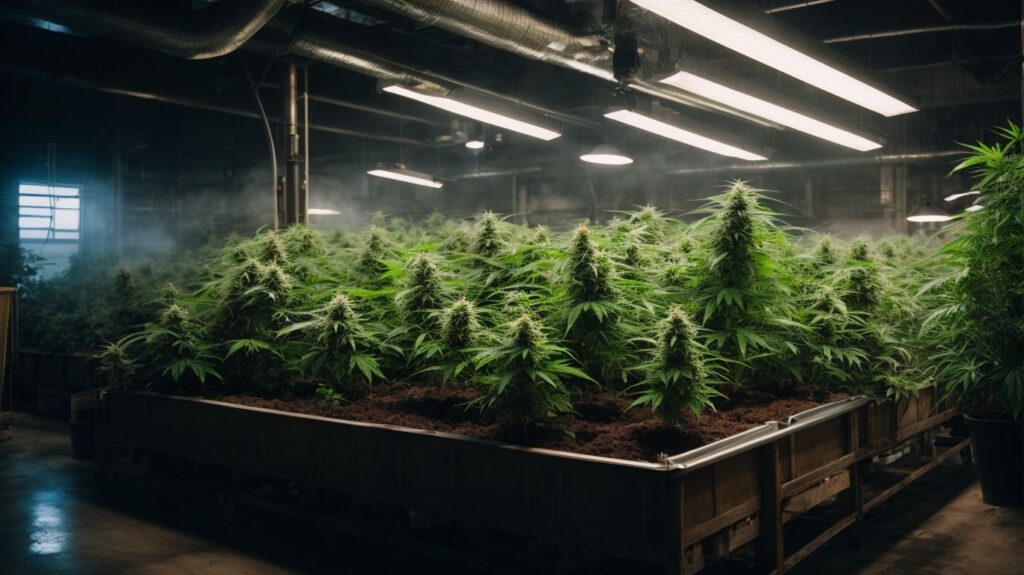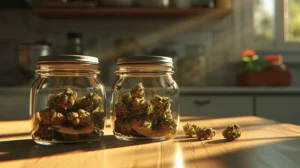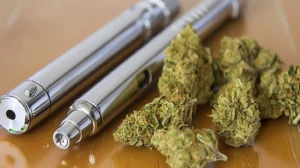Introduction to Cannabis Grow
Temperature and humidity control is crucial for any cannabis grower, whether you are growing for personal use or commercially. Proper control and optimisation of these factors are essential for creating an ideal environment for your plants to thrive and produce high-quality yields.
The ideal temperature and humidity levels for cannabis plants vary depending on the stage of growth. In the vegetative stage, the ideal temperature range is between 70-85°F (21-29°C) and humidity levels should be around 40-70%. In the flowering stage, the temperature should be slightly lower, between 65-80°F (18-26°C), and humidity levels should be around 40-50%.
High and low temperatures and humidity levels can have adverse effects on your cannabis plants. High temperatures and humidity can lead to mould and mildew growth, while low temperatures and humidity can cause stunted growth and nutrient deficiencies.
Controlling temperature and humidity in your grow space can be achieved through various methods. Proper ventilation, investing in a good dehumidifier, using air conditioning or heating systems, and creating a sealed grow space are all effective ways to control temperature and humidity levels.
To optimise temperature and humidity in your grow space, consider regularly monitoring and adjusting levels, using reflective materials to maximise light absorption, choosing the right growing medium, and investing in LED lights for energy efficiency.
Signs of temperature and humidity imbalance in your grow space include wilting leaves, mould growth, and slow growth. It is crucial to address these issues promptly to ensure the health and success of your plants.
In conclusion, by understanding the importance of temperature and humidity control, monitoring levels, and implementing proper techniques, you can create an optimal environment for your cannabis plants to thrive and produce high-quality yields.
Key Points:
Regular monitoring and adjustments are key to maintaining optimal temperature and humidity levels in your cannabis grow space. Proper ventilation, use of reflective materials, and choosing the right growing medium can help control and optimize temperature and humidity. High or low temperature and humidity levels can have negative effects on cannabis plants, so it’s important to invest in tools like dehumidifiers and air conditioning to maintain the ideal environment.
Why Is Temperature and Humidity Control Important for Cannabis Grow Spaces?
Maintaining optimal temperature and humidity levels is crucial for cannabis grow spaces. Fluctuations can impact plant growth, yield, and quality. Inadequate control can lead to mould, mildew, and pest infestations, affecting overall crop health and market value. Proper temperature and humidity promote photosynthesis, transpiration, and nutrient uptake, essential for robust plant development. Consistent conditions also support the activation of specific cannabinoids and terpenes, influencing the plant’s medicinal properties and overall potency. Additionally, controlling these factors ensures compliance with regulatory standards and facilitates a predictable cultivation environment. Therefore, understanding why temperature and humidity control is important for cannabis grow spaces is fundamental for successful and high-quality yields.
What Are the Ideal Temperature and Humidity Levels for Cannabis Plants?
As any experienced cannabis grower knows, maintaining the ideal temperature and humidity levels is crucial for the success of your plants. In this section, we will delve into what those ideal levels are for each stage of growth: the vegetative stage and the flowering stage. By understanding the specific requirements of each stage, you can ensure that your cannabis plants are thriving and producing the highest quality buds. So let’s dive in and discover the secrets to controlling and optimizing temperature and humidity in your cannabis grow space.
1. Vegetative Stage
During the vegetative stage, cannabis plants require specific environmental conditions to thrive. Maintain a temperature range of 70-85°F (21-29°C) during the day and a slightly lower temperature at night, around 60-70°F (15-21°C). Ensure relative humidity stays between 40-70% to prevent issues like mold or mildew. Provide 18 hours of light and 6 hours of darkness each day to promote vigorous growth.
2. Flowering Stage
During the 2nd flowering stage, maintain the temperature between 68-77°F (20-25°C) during the day and slightly cooler at night, around 50-68°F (10-20°C).
Keep humidity levels between 40-50% to prevent mould and mildew, crucial for bud development. Provide proper air circulation and ventilation to ensure even distribution of temperature and humidity. Consider using dehumidifiers or humidifiers to adjust humidity levels as needed. Utilise digital hygrometers and thermometers to monitor and maintain the ideal conditions.
What Are the Effects of High and Low Temperature and Humidity on Cannabis Plants?
Temperature and humidity are crucial factors in creating the ideal growing environment for cannabis plants. In this section, we will explore the effects of both high and low temperature and humidity on cannabis plants. By understanding these effects, growers can better control and optimise their grow space for healthy and thriving plants. First, we will discuss the potential consequences of high temperature and humidity, followed by the effects of low temperature and humidity on cannabis plants.
1. High Temperature and Humidity
When dealing with high temperature and humidity in your cannabis grow space, it’s crucial to take immediate action to prevent detrimental effects on your plants. Here are some steps to effectively manage this situation:
- Install proper ventilation to promote air circulation and reduce heat and moisture buildup.
- Utilize a good dehumidifier to maintain optimal humidity levels, preventing mold and mildew growth.
- Employ air conditioning or heating systems to regulate temperature fluctuations, ensuring an ideal environment for plant growth.
- Create a sealed grow space to control the entry of external hot and humid air, maintaining a stable internal climate.
A cannabis grower faced a sudden spike in temperature and humidity due to a malfunctioning ventilation system. Swiftly implementing these steps helped restore the ideal conditions, safeguarding the plants from heat stress and mold issues.
2. Low Temperature and Humidity
Low temperature and humidity can negatively affect cannabis plants during their growth cycle. In the vegetative stage, low temperatures can slow down metabolic processes, which can stunt growth and cause wilting. Similarly, in the flowering stage, low humidity levels can result in reduced resin production and compromised bud development.
To counter these effects, it’s important to maintain optimal temperature and humidity levels. Using heating systems and humidifiers can raise low temperature and humidity, respectively. Additionally, using airtight grow spaces and insulating materials can help retain heat and moisture. Regular monitoring and adjustments are essential to ensure the environment remains suitable for cannabis growth.
Utilising reflective materials and LED lights can also help stabilise temperature and humidity, while promoting healthy plant development.
How to Control Temperature and Humidity in Your Cannabis Grow Space?
Maintaining the right temperature and humidity levels is crucial for a successful cannabis grow. In this section, we will discuss the various methods and techniques for controlling temperature and humidity in your grow space. From proper ventilation to investing in a dehumidifier, we will cover the key steps you can take to create an optimal environment for your plants. Additionally, we will explore the benefits of creating a sealed grow space and the use of air conditioning or heating systems in achieving the ideal temperature and humidity levels.
1. Use Proper Ventilation
Ensure proper air circulation by using exhaust fans to remove stale air and introduce fresh air into the grow space. Position intake and exhaust fans strategically to create a consistent airflow throughout the entire space. Install oscillating fans to maintain uniform air distribution, preventing hot spots and humidity variance. Consider implementing a carbon filter in conjunction with ventilation to control odours and maintain a discreet operation. Proper ventilation is crucial for maintaining optimal temperature and humidity levels in cannabis grow spaces, promoting healthy plant growth and mitigating the risk of mould and mildew.
2. Invest in a Good Dehumidifier
Research: Look for dehumidifiers designed for growing spaces, with features like adjustable humidity settings, automatic shutoff, and sufficient capacity for your space.
Calculate Size: Determine the ideal dehumidifier size based on your grow room’s square footage and the specific humidity levels you need to maintain.
Placement: Position the dehumidifier strategically to ensure even humidity control throughout the entire grow space.
Maintenance: Regularly clean and maintain the dehumidifier to prevent mould and mildew growth, ensuring optimal functionality.
Monitor: Use a hygrometer to measure and monitor the humidity levels in the grow space, adjusting the dehumidifier as needed.
When investing in a good dehumidifier, prioritise energy efficiency and noise levels for a more sustainable and peaceful growing environment.
3. Use Air Conditioning or Heating Systems
Install an appropriate air conditioning or heating system based on the specific requirements of your cannabis grow space. Consider factors such as the size of the space, insulation, and environmental conditions in your region. Ensure that the chosen air conditioning or heating system provides precise temperature control to meet the specific needs of cannabis plants during different growth stages. Regularly maintain and service the air conditioning or heating system to ensure optimal functionality and prevent temperature fluctuations that could adversely affect the cannabis plants.
Integrate a thermostat or climate control system to monitor and regulate the temperature and humidity levels effectively. Seek professional guidance to determine the most suitable air conditioning or heating system for your cannabis grow space, taking into account energy efficiency and environmental impact.
A cannabis cultivator, faced with fluctuating temperatures in their grow space, installed a high-efficiency air conditioning system tailored to their cultivation area. This decision led to improved temperature control, creating an environment conducive to healthy plant growth and maximizing yield.
4. Create a Sealed Grow Space
Ensure airtight construction:
- Seal all potential air leaks in the grow space, including windows, doors, and vents, to prevent unwanted air exchange.
- Use weather-stripping: Apply weather-stripping around windows and doors to create a tight seal and minimize air infiltration.
- Install vapour barriers: Utilise vapour barriers such as plastic sheeting to control moisture levels and restrict airflow through walls and ceilings.
- Consider insulated panels: Utilise insulated panels for walls and ceilings to enhance thermal resistance and maintain a stable internal environment.
Tips for Optimising Temperature and Humidity in Your Cannabis Grow Space
As any experienced cannabis grower knows, temperature and humidity are crucial factors that can greatly impact the success of your plants. In this section, we will provide you with valuable tips on how to control and optimize these key elements in your grow space. From regularly monitoring and making adjustments to utilizing reflective materials and choosing the right growing medium, we cover all the essential techniques for maintaining the ideal temperature and humidity for your cannabis plants. Plus, we’ll also discuss the benefits of using LED lights in your grow space for optimal temperature and humidity control.
1. Monitor and Adjust Regularly
When maintaining cannabis grow spaces, monitoring and regular adjustments are crucial. Here’s a guide:
- Install a reliable hygrometer and thermometer to accurately measure temperature and humidity levels.
- Record and track daily readings to identify patterns and potential issues.
- Adjust ventilation systems, dehumidifiers, or heating/cooling devices as needed based on the recorded data.
- Regularly inspect plants for any signs of stress or damage related to temperature and humidity imbalances.
- Implement changes gradually to avoid sudden fluctuations that could stress the plants.
A friend’s meticulous monitoring and adjustments led to thriving cannabis plants with impressive yields, showcasing the importance of regular vigilance in creating an optimal grow environment.
2. Use Reflective Materials
Choose reflective materials such as Mylar or white plastic to line the walls of the grow space.
Ensure that the reflective material is securely and evenly placed to optimise light distribution.
Consider using reflective films or paints on the ceiling and floor to enhance light reflection.
Regularly clean and maintain the reflective surfaces to ensure maximum light reflection efficiency.
3. Choose the Right Growing Medium
Consider the specific needs of your cannabis plants when choosing the growing medium. Evaluate factors such as water retention, aeration, and nutrient content of the medium. Options include:
- soil, which offers a traditional approach with reliable nutrient content.
- coco coir, which provides excellent aeration and water retention.
- perlite and vermiculite, which enhance soil aeration and drainage when used as additives.
- soilless mixes like peat-based or coco-based mediums, which offer precise control over nutrient content and drainage.
In 1961, the first recorded use of perlite as a growing medium for horticultural purposes was documented. This marked a significant shift in the cultivation of plants, especially in controlled indoor environments.
4. Consider Using LED Lights
- Assess the space: Determine the appropriate number and type of LED lights needed based on the size and layout of your grow space.
- Choose the right spectrum: Select LED lights with a spectrum tailored to meet the specific needs of cannabis plants during each stage of growth, including vegetative and flowering phases.
- Manage heat output: Opt for LED lights with efficient heat dissipation to maintain the ideal temperature within the grow space.
- Adjust light intensity: Regulate the intensity of the LED lights according to the growth stage of the cannabis plants, ensuring they receive optimal light levels.
- Monitor performance: Regularly check the performance of the LED lights to ensure they are functioning properly and providing the necessary light for healthy plant growth.
What Are the Signs of Temperature and Humidity Imbalance in Your Cannabis Grow Space?
In your cannabis grow space, signs of temperature and humidity imbalance can include stunted growth, wilting, yellowing leaves, mold growth, heat stress, and excessive transpiration.
Stunted growth and wilting are often indicators of high temperatures and low humidity. Conversely, yellowing leaves may signal low temperatures and high humidity. Mold growth indicates excess humidity, while heat stress and excessive transpiration can result from high temperatures and low humidity.
Monitoring and adjusting temperature and humidity levels are crucial for maintaining a healthy cannabis grow space. Implementing proper ventilation, using dehumidifiers or humidifiers, and employing temperature control systems are essential for creating an optimal environment for cannabis cultivation.
Frequently Asked Questions
What are the ideal temperature levels for different stages of cannabis growth?
The optimal temperature range for cannabis growth is between 70-85°F (20-30°C) during the day and slightly cooler at night. During the vegetative stage, aim for temperatures in the 70-85°F (20-30°C) range, while in the flowering stage, it’s best to keep temperatures slightly cooler at 65-80°F (18-26°C) for better bud quality.
How can I control the temperature within my cannabis grow space?
There are 7 essential concepts to keep in mind for temperature control, including the use of vents to exhaust hot air, the misconception that fans can bring down the temperature (they only provide a breeze), and the use of AC or evaporative coolers to lower the temperature. Proper temperature control can also bring out colors and increase bud quality.
What are the key factors to consider for optimizing humidity levels in a cannabis grow room?
Humidity is crucial for healthy cannabis plant growth, with different life stages having specific humidity requirements. Aim for a humidity range of 40-60% during the vegetative stage and slightly lower levels of 40-50% during the flowering stage. Proper ventilation, managing heat sources, and using humidity control tools such as plastic humidity domes can help maintain the appropriate range.
How do HVAC parameters affect humidity and temperature levels in a cannabis grow space?
Proper HVAC humidity control is critical for maintaining a healthy growing environment for cannabis plants. HVAC parameters such as ventilation, air temperature, and humidity levels can impact the transpiration rate, nutrient absorption, and overall health of the plants. It’s essential to carefully manage these parameters to ensure optimal conditions for healthy growth.
Can using LED grow lights help with temperature and humidity control in a cannabis grow room?
Yes, using energy-efficient LED grow lights can help regulate the temperature and humidity levels in a cannabis grow space. LED lights produce less heat than traditional HID lights, reducing the need for extra heating or cooling. Additionally, LED intensity can be adjusted, making them a practical solution for maintaining the ideal breeding ground for cannabis plants.
How can controlling temperature and humidity levels benefit cannabis production?
Proper temperature and humidity control are critical components for successful grow room operations and can significantly impact the final product. Maintaining the optimal conditions can lead to healthier plants, ward off pests and diseases, and result in higher quality and yield. It also helps conserve energy and lower operational expenses.






